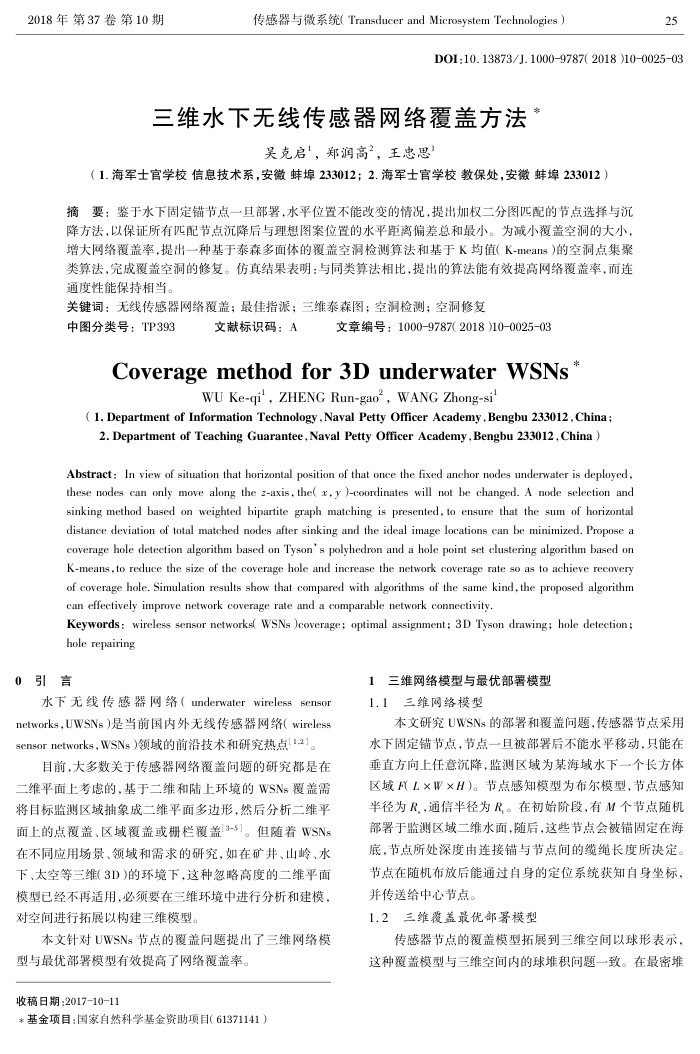您当前的位置:首页>论文资料>三维水下无线传感器网络覆盖方法
内容简介
 2018年第37卷第10期
2018年第37卷第10期传感器与微系统(Transducer and Microsystem Technologies)
25
DOI:10.13873/J.10009787( 2018 )10002503
三维水下无线传感器网络覆盖方法
吴克启,郑润高”,王忠思
(1.海军士官学校信息技术系,安徽蚌埠233012;2.海军士官学校教保处,安徽蚌埠233012)
摘要:鉴于水下固定锚节点一且部署,水平位置不能改变的情况,提出加权二分图匹配的节点选择与沉降方法,以保证所有匹配节点沉降后与理想图案位置的水平距离偏差总和最小。为减小覆盖空洞的大小,
类算法,完成覆盖空洞的修复。仿真结果表明:与同类算法相比,提出的算法能有效提高网络覆盖率,而连通度性能保持相当。
关键词:无线传感器网络覆盖;最佳指派;三维泰森图;空洞检测;空洞修复
中图分类号:TP393
文章编号:1000-9787(2018)10-0025-03
文献标识码:A
Coverage method for 3D underwater WSNs
WU Ke-qi',ZHENG Run-gao",WANG Zhong-si'
(1.Department of Information Technology,Naval Petty Officer Academy,Bengbu 233012,China: 2.Department of Teaching Guarantee,Naval Petty Officer Academy,Bengbu 233012,China)
Abstract: In view of situation that horizontal position of that once the fixed anchor nodes underwater is deployed, these nodes can only move along the z-axis, the( x, y )-coordinates will not be changed. A node selection and sinking method based on weighted bipartite graph matching is presented, to ensure that the sum of horizontal distance deviation of total matched nodes after sinking and the ideal image locations can be minimized. Propose a coverage hole detection algorithm based on Tyson' s polyhedron and a hole point set clustering algorithm based on K-means , to reduce the size of the coverage hole and increase the network coverage rate so as to achieve recovery of coverage hole. Simulation results show that compared with algorithms of the same kind, the proposed algorithm can effectively improve network coverage rate and a comparable network connectivity
Keywords : wireless sensor networks( WSNs )coverage; optimal assignment; 3D Tyson drawing; hole detection ; hole repairing
0引言
水下无线传感器网络(underwaterwirelesssensor networks,UWSNs)是当前国内外无线传感器网络(wireless sensornetworks,WSNs)领域的前沿技术和研究热点[1.2]。
目前,大多数关于传感器网络覆盖间题的研究都是在二维平面上考虑的,基于二维和陆上环境的WSNs覆盖需将目标监测区域抽象成二维平面多边形,然后分析二维平面上的点覆盖、区域覆盖或栅栏覆盖[3-5]。但随着WSNs 在不同应用场景、领域和需求的研究,如在矿井、山岭、水下、太空等三维(3D)的环境下,这种忽略高度的二维平面模型已经不再适用,必须要在三维环境中进行分析和建模,对空间进行拓展以构建三维模型。
本文针对UWSNs节点的覆盖问题提出了三维网络模
型与最优部署模型有效提高了网络覆盖率。收稿日期:2017-10-11
*基金项目:国家自然科学基金资助项目(61371141)
1三维网络模型与最优部署模型 1.1三维网络模型
本文研究UWSNs的部署和覆盖问题,传感器节点采用水下固定锚节点,节点一且被部署后不能水平移动,只能在垂直方向上任意沉降,监测区域为某海域水下一个长方体区域FL×W×H)。节点感知模型为布尔模型,节点感知半径为R,通信半径为R。在初始阶段,有M个节点随机部著于监测区域二维水面,随后,这些节点会被锚固定在海底,节点所处深度由连接错与节点间的缆绳长度所决定。节点在随机布放后能通过自身的定位系统获知自身坐标并传送给中心节点。
1.2三维覆盖最优部署模型
传感器节点的覆盖模型拓展到三维空间以球形表示这种覆盖模型与三维空间内的球堆积问题一致。在最密堆